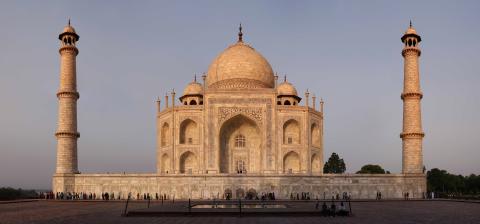More than twenty members of our Arts Society flew out in October 2025 for a short but fascinating trip discovering th
The Architecture of Mughal Indian: Palaces, Mosques, Gardens and Mausoleums
The Architecture of Mughal Indian: Palaces, Mosques, Gardens and Mausoleums
15 Apr 2025
Lecture by Dr John Stevens
The Arts Society Horsham - 9 April 2025
Although there were no April showers to dodge, members of the Arts Society Horsham were happily ensconced in the comfort of the Brighton Road Baptist Church for a fascinating lecture on the architectural achievements of the Mughal Empire which spanned from the16th to the 18th Century.
The Mughal Empire was founded in 1526 by Babur, a descendant of Genghis Khan. Babur quite literally laid the early foundation of Mughal edifices and gardens by commissioning artisans and craftsmen from Persia and across the empire. It was evident that a Mughal civilisation was to be a patronage of art and this tradition was inherited by the succession of Mughals, notably Akbar, Jahangir and Shah Jahan.
As the empire became enriched from taxation and the patronage of the nobility, the artistic designs and creations reflected the exquisite skills and diverse influence from Islamic, Persian, Turkish and Indian traditions as well as reference to European art. We were guided through some of the most beautiful architectural gems of palaces, mosques and mausoleums and the hidden meanings that governed the design and location of their construction. At a superficial level, the buildings were an expression of power in an elaborate gesture of self-aggrandisement. However, beneath the marbled facades and gold inlaid interiors, there lies a spiritual dimension of the Islamic belief of the after life. These edifices are typically situated in a garden on a geometric grid pattern. The interaction between gardens and buildings is a significant and characteristic interpretation of “The garden of Eden” which is known to be located in Mesopotamia.
Using the grandest design of the Taj Mahal, built by Shah Jahan for his beloved wife, Mumtaz Mahal, we learnt to decipher its rich symbolisms. The dome represents the celestial and the cubes the earthly realm. The grid of the garden design with its quadrants symbolise the four rivers where water, wine, milk and honey flow. Even the plants take on the meaning of the renewal of life. Flowering motifs inspired by Florentine inlaid of pietre dure decorate the walls of the cenotaph. The metaphor continues in the opulent interior - the eight levels denote paradise and the planets of the universe. This most beautiful and romantic Mughal mausoleum takes on a cosmic symbolic scale in creating a paradise on Earth!
There is much to be learnt and admired of the sophistication and enduring legacy in art and architecture of the Mughal empire. Some of the earthly delights have remained and we were urged to visit before long! A shorter journey than New Delhi will be the V&A in South Kensington with its current exhibition “The Great Mughals: Art, Architecture and Opulence” which closes on 5 May 2025.
JOIN OUR MAILING LIST
Become an instant expert!
Find out more about the arts by becoming a Supporter of The Arts Society.
For just £20 a year you will receive invitations to exclusive member events and courses, special offers and concessions, our regular newsletter and our beautiful arts magazine, full of news, views, events and artist profiles.
FIND YOUR NEAREST SOCIETY
MORE FEATURES
Year in Review: A Remarkable Year for The Arts Society Mallorca
Our Heritage Volunteers are working as part of a team working on the rewarding book restoration proj






